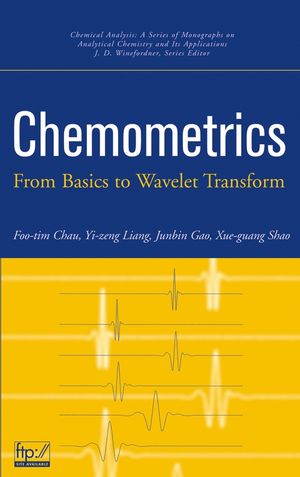Chemometrics: From Basics to Wavelet TransformISBN: 978-0-471-20242-4
Hardcover
336 pages
March 2004
 This is a Print-on-Demand title. It will be printed specifically to fill your order. Please allow an additional 15-20 days delivery time. The book is not returnable.
|
||||||
CHAPTER 1: INTRODUCTION.
1.1. Modern Analytical Chemistry.
1.1.1. Developments in Modern Chemistry.
1.1.2. Modern Analytical Chemistry.
1.1.3. Multidimensional Dataset.
1.2. Chemometrics.
1.2.1. Introduction to Chemometrics.
1.2.2. Instrumental Response and Data Processing.
1.2.3. White, Black, and Gray Systems.
1.3. Chemometrics-Based Signal Processing Techniques.
1.3.1. Common Methods for Processing Chemical Data.
1.3.2. Wavelets in Chemistry.
1.4. Resources Available on Chemometrics and Wavelet Transform.
1.4.1. Books.
1.4.2. Online Resources.
1.4.3. Mathematics Software.
CHAPTER 2: ONE-DIMENSIONAL SIGNAL PROCESSING TECHNIQUES IN CHEMISTRY.
2.1. Digital Smoothing and Filtering Methods.
2.1.1. Moving-Window Average Smoothing Method.
2.1.2. Savitsky--Golay Filter.
2.1.3. Kalman Filtering.
2.1.4. Spline Smoothing.
2.2. Transformation Methods of Analytical Signals.
2.2.1. Physical Meaning of the Convolution Algorithm.
2.2.2. Multichannel Advantage in Spectroscopy and Hadamard Transformation.
2.2.3. Fourier Transformation.
2.2.3.1. Discrete Fourier Transformation and Spectral Multiplex Advantage.
2.2.3.2. Fast Fourier Transformation.
2.2.3.3. Fourier Transformation as Applied to Smooth Analytical Signals.
2.2.3.4. Fourier Transformation as Applied to Convolution and Deconvolution.
2.3. Numerical Differentiation.
2.3.1. Simple Difference Method.
2.3.2. Moving-Window Polynomial Least-Squares Fitting Method.
2.4. Data Compression.
2.4.1. Data Compression Based on B-Spline Curve Fitting.
2.4.2. Data Compression Based on Fourier Transformation.
2.4.3. Data Compression Based on Principal-Component Analysis.
CHAPTER 3: TWO-DIMENSIONAL SIGNAL PROCESSING TECHNIQUES IN CHEMISTRY.
3.1. General Features of Two-Dimensional Data.
3.2. Some Basic Concepts for Two-Dimensional Data from Hyphenated Instrumentation.
3.2.1. Chemical Rank and Principal-Component Analysis (PCA).
3.2.2. Zero-Component Regions and Estimation of Noise Level and Background.
3.3. Double-Centering Technique for Background Correction.
3.4. Congruence Analysis and Least-Squares Fitting.
3.5. Differentiation Methods for Two-Dimensional Data.
3.6 Resolution Methods for Two-Dimensional Data.
3.6.1. Local Principal-Component Analysis and Rankmap.
3.6.2. Self-Modeling Curve Resolution and Evolving Resolution Methods.
3.6.2.1. Evolving Factor Analysis (EFA).
3.6.2.2. Window Factor Analysis (WFA).
3.6.2.3. Heuristic Evolving Latent Projections (HELP).
CHAPTER 4: FUNDAMENTALS OF WAVELET TRANSFORM.
4.1. Introduction to Wavelet Transform and Wavelet Packet Transform.
4.1.1. A Simple Example: Haar Wavelet.
4.1.2. Multiresolution Signal Decomposition.
4.1.3. Basic Properties of Wavelet Function.
4.2. Wavelet Function Examples.
4.2.1. Meyer Wavelet.
4.2.2. B-Spline (Battle—Lemarié) Wavelets.
4.2.3. Daubechies Wavelets.
4.2.4. Coiflet Functions.
4.3. Fast Wavelet Algorithm and Packet Algorithm.
4.3.1. Fast Wavelet Transform.
4.3.2. Inverse Fast Wavelet Transform.
4.3.3. Finite Discrete Signal Handling with Wavelet Transform.
4.3.4. Packet Wavelet Transform.
4.4. Biorthogonal Wavelet Transform.
4.4.1. Multiresolution Signal Decomposition of Biorthogonal Wavelet.
4.4.2. Biorthogonal Spline Wavelets.
4.4.3. A Computing Example.
4.5. Two-Dimensional Wavelet Transform.
4.5.1. Multidimensional Wavelet Analysis.
4.5.2. Implementation of Two-Dimensional Wavelet Transform.
CHAPTER 5: APPLICATION OF WAVELET TRANSFORM IN CHEMISTRY.
5.1. Data Compression.
5.1.1. Principle and Algorithm.
5.1.2. Data Compression Using Wavelet Packet Transform.
5.1.3. Best-Basis Selection and Criteria for Coefficient Selection.
5.2. Data Denoising and Smoothing.
5.2.1. Denoising.
5.2.2. Smoothing.
5.2.3. Denoising and Smoothing Using Wavelet Packet Transform.
5.2.4. Comparison between Wavelet Transform and Conventional Methods.
5.3. Baseline/Background Removal.
5.3.1. Principle and Algorithm.
5.3.2. Background Removal.
5.3.3. Baseline Correction.
5.3.4. Background Removal Using Continuous Wavelet Transform.
5.3.5. Background Removal of Two-Dimensional Signals.
5.4. Resolution Enhancement.
5.4.1. Numerical Differentiation Using Discrete Wavelet Transform.
5.4.2. Numerical Differentiation Using Continuous Wavelet Transform.
5.4.3. Comparison between Wavelet Transform and other Numerical Differentiation Methods.
5.4.4. Resolution Enhancement.
5.4.5. Resolution Enhancement by Using Wavelet Packet Transform.
5.4.6. Comparison between Wavelet Transform and Fast Fourier Transform for Resolution Enhancement.
5.5. Combined Techniques.
5.5.1. Combined Method for Regression and Calibration.
5.5.2. Combined Method for Classification and Pattern Recognition.
5.5.3. Combined Method of Wavelet Transform and Chemical Factor Analysis.
5.5.4. Wavelet Neural Network.
5.6. An Overview of the Applications in Chemistry.
5.6.1. Flow Injection Analysis.
5.6.2. Chromatography and Capillary Electrophoresis.
5.6.3. Spectroscopy.
5.6.4. Electrochemistry.
5.6.5. Mass Spectrometry.
5.6.6. Chemical Physics and Quantum Chemistry.
5.6.7. Conclusion.
APPENDIX VECTOR AND MATRIX OPERATIONS AND ELEMENTARY MATLAB.
A.1. Elementary Knowledge in Linear Algebra.
A.1.1. Vectors and Matrices in Analytical Chemistry.
A.1.2. Column and Row Vectors.
A.1.3. Addition and Subtraction of Vectors.
A.1.4. Vector Direction and Length.
A.1.5. Scalar Multiplication of Vectors.
A.1.6. Inner and Outer Products between Vectors.
A.1.7. The Matrix and Its Operations.
A.1.8. Matrix Addition and Subtraction.
A.1.9. Matrix Multiplication.
A.1.10. Zero Matrix and Identity Matrix.
A.1.11. Transpose of a Matrix.
A.1.12. Determinant of a Matrix.
A.1.13. Inverse of a Matrix.
A.1.14. Orthogonal Matrix.
A.1.15. Trace of a Square Matrix.
A.1.16. Rank of a Matrix.
A.1.17. Eigenvalues and Eigenvectors of a Matrix.
A.1.18. Singular-Value Decomposition.
A.1.19. Generalized Inverse.
A.1.20. Derivative of a Matrix.
A.1.21. Derivative of a Function with Vector as Variable.
A.2. Elementary Knowledge of MATLAB.
A.2.1. Matrix Construction.
A.2.2. Matrix Manipulation.
A.2.3. Basic Mathematical Functions.
A.2.4. Methods for Generating Vectors and Matrices.
A.2.5. Matrix Subscript System.
A.2.6. Matrix Decomposition.
A.2.6.1. Singular-Value Decomposition (SVD).
A.2.6.2. Eigenvalues and Eigenvectors (eig).
A.2.7. Graphic Functions 288
INDEX.



